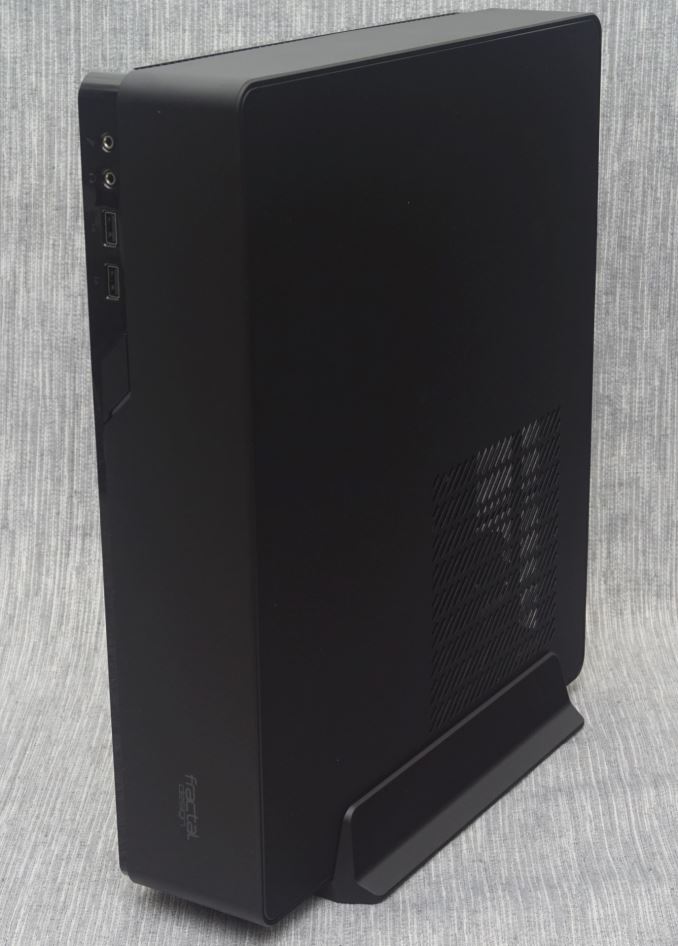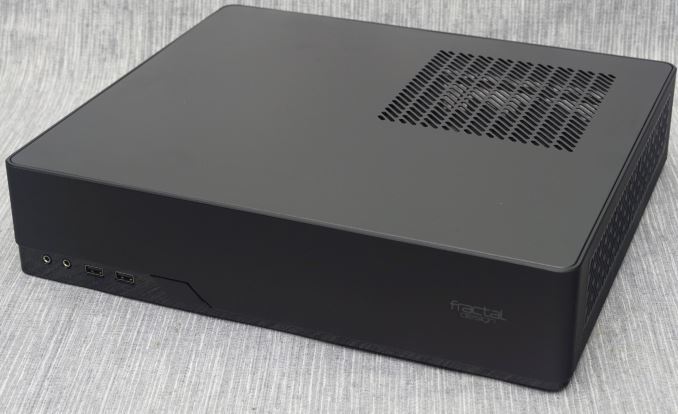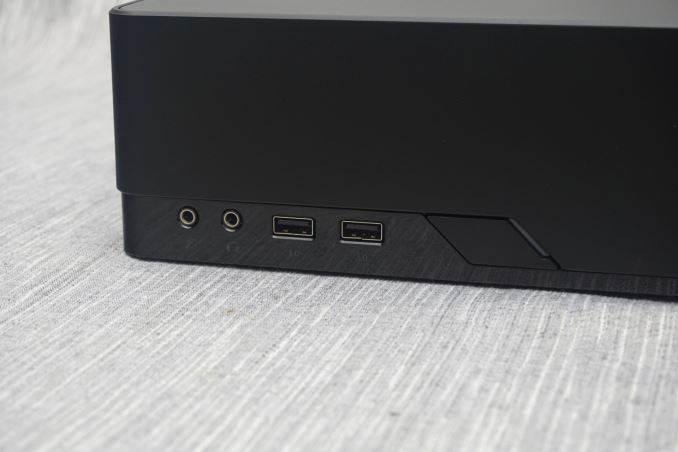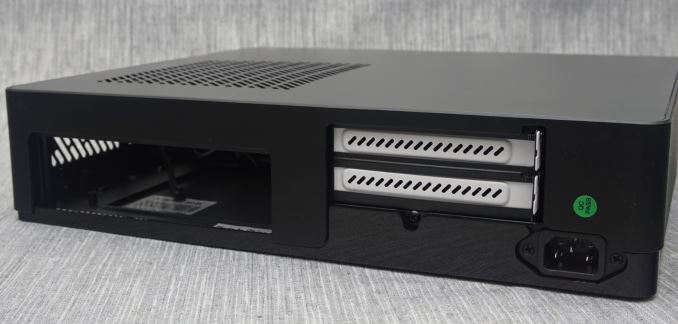The Fractal Design Node 202 Case Review: Mini-ITX Gaming For the Living Room
by E. Fylladitakis on June 6, 2016 9:15 AM EST- Posted in
- Cases/Cooling/PSUs
- Mini ITX
- HTPC
- Fractal Design
- ITX
The Exterior of the Fractal Design Node 202
Physically, the size and design of the Node 202 strongly resembles that of an old school VCR. It is a minimalistic design, made of straight lines and basic geometric shapes. It can be placed both horizontally, using the provided rubber feet, or vertically, using the provided plastic support frame. Most of the case has been sprayed with a matte black paint that is highly resistant to fingerprints. The lower part of the Node 202 is the one exception to this; it's glossy and highly reflective, and hence will pick up fingerprints.
Measuring 8.2 cm tall, 37.7 cm wide and 33 cm deep (3.25 × 14.85 × 13 in), resulting to a volume of just 10.2 liters, the Node 202 is much smaller than any ITX gaming case that we have previously tested, such as the Cougar QBX (19.9 liters, 95% larger) and the Corsair 250D (28.2 liters, 177% larger).
At first sight, the Node 202 appears to be just another slim HTPC case that forbids the use of full size expansion cards, a design that effectively negates the installation of any high performance video card, making it useless to gamers. That however is not true, as the Node 202 can accommodate a full size video card up to 310 mm long, comfortably over the roughly 280mm average for high-end cards..
The I/O ports can be seen to the left of the simple faceplate. From left to right, we can see two 3.5 mm headphone jacks, two USB 3.0 ports and a rhomboid power button.
The rear of the Node 202 is interesting, as we cannot see a place for the PSU but only a receptacle, hinting that Fractal Design moved the PSU compartment to the front of the case. There are also two white expansion card slot covers. There are no slots for fans and no vents above the motherboard’s I/O panel.














64 Comments
View All Comments
FLHerne - Monday, June 6, 2016 - link
The pictures show a mic icon under the left socket, so it's (unsurprisingly) the body text that's wrong.romrunning - Monday, June 6, 2016 - link
"When placed vertically, depending on the system and setup, it is wise to place the Node 202 with its left side down, as the right side offers some ventilation to the CPU/Motherboard area."Ironically, the vertical-standing case pic on page 2 shows the exact opposite - the case is standing on the right side, basically covering the ventilation.
JoeyJoJo123 - Monday, June 6, 2016 - link
I'd argue this isn't really meant as a HTPC, despite the form factor, because of the lack of 3.5" drive support (most HTPCs are used as a means to playback videos, and many videos take lots of storage, and lots of storage requires the usage of multiple 3.5" drives). No 5.25" drive bay is actually OK since most users can just get an external 5.25" BDR drive, or whatever.It's really meant as a mobile/LAN party mini PC, where you can fit powerful current-gen desktop parts and still have it actually fit inside a large backpack, along with peripherals and cables, while you hold a monitor in your hands. It's also good for users who move/travel a lot, like those in the military, moving from one location to another every few months.
Some notes for people interested in the case:
1) It's most economical to get the case with the included Integra SFX PSU, as it comes out to a 450W 80+ Bronze for $50 + Case for $80, assuming a $130 cost for the package. Yes, you can get modular PSUs and such, but you'll be paying extra for that, and the Integra SFX actually does have shorter cables optimized to fit the Node 202 well. SFX-L power supplies from Silverstone fit, but reduce your available cable routing options by quite a bit. It's best to stick with SFX. If you need SFX-L, look to the FTZ-01 or the ML07-B for a slightly larger, but similar form factor case.
2) You can watercool the CPU with a slim 120mm AIO CLC kit with flexible tubing, however, this requires some modification of the case and limits your GPU choices to either an R9 Nano or possibly even a GTX 970 mini, but I'm not sure on the latter. Google "Challenge Accepted: Liquid Cooling in the Fractal Node 202!?" for a video.
3) The largest and most effective air cooler you can place in here is a Thermalright AXP-100R, at 60mm, but this requires removing the top dustcover from above the motherboard area. The AXP-100R (not the AXP-100 Muscle) includes a bracket to install slim 120 mounting fans onto the heatsink. This lets you mount a slim 140mm fan with 120mm mounting holes on the heatsink. TechPowerUp's Node 202 review shows the AXP-100R in use with the stock fan.
4) If you got lots of stuff you want to store, it's possible to get a mini-ITX board with an m.2 slot on the back of the motherboard, and use both of 2.5" drive bays for 2TB 5400 rpm drives. You can improve the responsiveness of these drives by opting to use them in RAID 0, and possibly using the M.2 as SSD cache through Intel RST, but this is a pretty risky move. You can stuff a 3rd or possibly 4th 2.5" drive into the case without securing it with screws, but be aware that the Integra SFX is optimized for the Node 202 and has only 2 SATA power connectors. Sure the drives won't fall out, but this situation isn't exactly ideal.
5) The case's thermals are probably its worst aspect, and it's not exactly the ideal enclosure if your intention is to load it up with the most powerful hardware and get a big overclock out of your CPU. If that's your intention, you'll definitely want to opt for a larger cube-like ITX case.
In all, this case is very niche. It's for users who need a really mobile desktop on the cheap, but are willing to sacrifice thermal performance. It's most ideal for a non-overclocked system (H170 platform) due to the thermal performance of the case, but those want to overclock and want a small form factor are capable of doing that, too, if they're up to the challenge.
If money is no object to you and you want the absolute smallest ITX system, look for the Dan A4. It's ~$265 to back on Kickstarter and would theoretically ship at the end of this year.
auzn - Monday, June 6, 2016 - link
HTPC does not need to have a large storage. That is what NAS is for.JoeyJoJo123 - Monday, June 6, 2016 - link
1) Most people don't have anything more than 1 desktop-sized PC in their living space, and many don't even have a PC, period.2) Of the extravagant few that do have multiple PCs in their living space, it's often a case of 1 PC-per-person, and possibly a shared/guest PC.
3) Of the increasingly smaller number of people that have HTPC sized PCs attached to their entertainment center, even fewer will have an additional NAS PC as well.
All that being said, of the people that have an HTPC attached to their entertainment center at all, very few will also have a NAS, too, so it's important to consider this device in isolation, rather than taking for granted that "Oh, any dude that buys this has a completely separate NAS in their house" which is completely dumb to assume.
Oh, and thanks for the 2 sentence response, bro.
dsraa - Monday, June 6, 2016 - link
While i agree with you, logic does dicatate that a NAS would make sense for this kind of scenario. This isn't meant as a one purpose fits all sizes type of use. Or neceassrily as a primary 'solo' system.So going forward, you'd have to adapt to the situation. If I were to be buying this as a HTPC/gaming, it would be used for streaming, not as a storage based multimedia system that would host movies, photos, and music. I would use or purchase a NAS for all of that OR, OR I would buy just a different case that had room for a 3.5 HDD or 2.
Icehawk - Monday, June 6, 2016 - link
HD enclosures aren't terribly expensive nor are usb drives if there isn't a NAS or other PC as storage options. Heck many wifi routers allow direct connection of an usb hard drive too.LostWander - Monday, June 6, 2016 - link
Thanks for the awesome post! I've been looking into building an ITX system to follow my way too big tower and while I might not go with this build you've got some great general points.ameanie - Monday, June 6, 2016 - link
Thank you so much for all this information on this case. I've been trying to find the best case that has a similar design to this while also trying to account for being able to cool it as well as possible (if I have to watercool, I don't mind but I have 0 experience with it)My intentions are to have an i7 6700k and a (probably) EVGA GTX 1080 in the build, but I've been having a hard time finding a case that's thin and can house those and deal with heat. Do you have any suggestions for that? Is it only possible to do it with a cube-like ITX case? I really want to save as much space as possible I live in a really small place and don't mind saving the necessary money to build the right thing for myself..
ameanie - Monday, June 6, 2016 - link
apparently there is no omment editing here? but...Not to mention picking a motherboard. I'm way in over my head trying to plan a build that will last for a long time while also being able to handle all the things I intend on doing (image/video editing, high end gaming/streaming) while staying cool and calm.